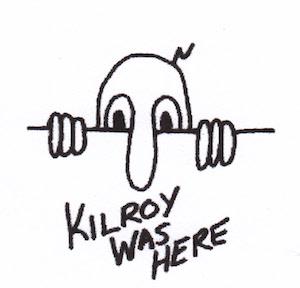 October 28, 2019 - If you were born prior to WWII you probably knew Kilroy. You might have had a yellow or orange lapel pin with his nose hanging over the label, and the top of his hands hanging over the label, too. I really never knew why Kilroy was so popular, or who he was, but I joined in the fun of “Kilroy Was Here”, but who the heck was Kilroy? Where did he come from and how did he get so world famous?
October 28, 2019 - If you were born prior to WWII you probably knew Kilroy. You might have had a yellow or orange lapel pin with his nose hanging over the label, and the top of his hands hanging over the label, too. I really never knew why Kilroy was so popular, or who he was, but I joined in the fun of “Kilroy Was Here”, but who the heck was Kilroy? Where did he come from and how did he get so world famous?
The search for Kilroy officially began in 1946 when the radio program “Speak To America” sponsored a nationwide contest to find the REAL Kilroy, offering a prize of a real trolley car to the person who could prove himself to be the genuine article. Almost 40 men stepped forward to make that claim, but only James Kilroy from Halifax, Massachusetts, had evidence of his identity.
It seems that the “Kilroy Was Here” began quite by accident. Mr. James Kilroy worked as a checker at the Fore River Shipyard in Quincy. His job was to go around and check on the number of rivets that had been produced. Riveters were on a piece-work and got paid by each rivet produced.
Kilroy would count a block of rivets and put a check mark in semi-waxed lumber chalk, so the rivets would not be counted twice. However, when Kilroy went off duty, the riveters would erase his mark. Later on, an off-shift inspector would come through and count the rivets a second time, resulting in double pay for the riveters.
His boss called Kilroy on the carpet about all the extra wages being paid to riveters, and asked him to investigate. After checking he realized what had been going on behind his back. Rejecting paint, Kilroy opted to stick with the waxy chalk. He continued to put his checkmark on each job he inspected, but added “Kilroy Was Here” in large letters next to the check mark. He eventually added the sketch of the chap with the long nose peering over the fence. This all became a part of the Kilroy message. Once he did that the riveters stopped trying to wipe away his marks.
Ordinarily the rivets and chalk marks would have been covered with paint. However, with the war on, ships were leaving the Quincy Yard so fast that there was not time to paint them. As a result, Kilroy’s inspection “trademark” was seen by thousands of servicemen who boarded the troop ships the yard had produced. This message apparently rang a bell with the servicemen because they picked it up and spread it all over Europe and the South Pacific. Before the war’s end, “Kilroy” had been there, here, and everywhere on the long hauls to Berlin and Tokyo.
To the outbound troops in those ships, however, he was a complete mystery; all they knew for sure was that some jerk named Kilroy had “been there first.” As a joke, U.S. servicemen began placing the graffiti wherever they landed, claiming it was already there when they arrived.
As the war went on, the legend grew. Underwater demolition teams routinely sneaked ashore on Japanese-held islands in the Pacific to map the terrain for coming invasions by U.S. troops and left the logo. In 1945, an outhouse was built for the exclusive use of Roosevelt, Stalin, and Churchill at the Potsdam conference. Its first occupant was Stalin, who emerged and asked his aide, “Who is Kilroy?”
To help prove his authenticity in 1946, James Kilroy brought along officials from the shipyard and some of the riveters. He proved his case and won the trolley car, which he gave to his nine children as a Christmas gift. It was set up as a playhouse in the Kilroy front yard in Halifax, Massachusetts.
Now you know who and what Kilroy was. I can remember owning one of the lapel pins which I put in my top coat pocket on occasion. You might still find one at a garage sale somewhere if you look carefully.
Yes, “Kilroy Was Here” truly was an American phenomenon which helped our country through the war quite by accident. And now you know.









